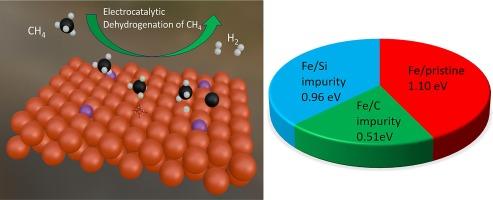Mimicking characteristics of cast iron for enhanced electrocatalytic dehydrogenation of methane
IF 6.7
1区 工程技术
Q2 ENERGY & FUELS
引用次数: 0
Abstract
Enhancing the efficiency of methane dehydrogenation through chemical modification of electrocatalytic iron surfaces with impurities that resemble cast iron properties is demonstrated computationally using Density Functional Theory methodologies. Investigating methane dehydrogenation on thermally stable Fe surfaces with discrete planes and anchoring impurities such as Al, C, and Si minimized reduction barriers. Electrochemical treatment of methane on these robust surfaces yields clean hydrogen and carbon-based compounds, such as carbon nanomaterials and carbon black. As for the most efficient active sites for enhanced methane dehydrogenation, the active plane 100 with 5.5 % C impurities and 0.51 eV reduction barrier is determined to be the most dependable, followed by the active plane 110 with 5.5 % Si impurities and the lower 0.98 eV reduction barrier. Utilizing CI-NEB (Nudged Elastic Band), the dissociation barrier investigation established the electrolytic catalysts’ performance. This work paves the way for experimentalists and demonstrates the economic viability of Fe-based catalysts for the Catalytic Dehydrogenation of Methane.

模拟铸铁特性以增强甲烷的电催化脱氢作用
利用密度泛函理论方法,通过对具有类似铸铁特性的杂质的电催化铁表面进行化学修饰,提高了甲烷脱氢的效率。研究甲烷在具有离散平面和锚定杂质(如 Al、C 和 Si)的热稳定铁表面上的脱氢过程,最大限度地降低了还原障碍。在这些坚固的表面上对甲烷进行电化学处理,可产生清洁的氢气和碳基化合物,如碳纳米材料和炭黑。关于增强甲烷脱氢的最有效活性位点,含 5.5% C 杂质和 0.51 eV 还原势垒的活性平面 100 被认为是最可靠的,其次是含 5.5% Si 杂质和较低 0.98 eV 还原势垒的活性平面 110。利用 CI-NEB(裸弹带)进行的解离势垒研究确定了电解催化剂的性能。这项工作为实验人员铺平了道路,并证明了将铁基催化剂用于甲烷催化脱氢的经济可行性。
本文章由计算机程序翻译,如有差异,请以英文原文为准。
求助全文
约1分钟内获得全文
求助全文
来源期刊

Fuel
工程技术-工程:化工
CiteScore
12.80
自引率
20.30%
发文量
3506
审稿时长
64 days
期刊介绍:
The exploration of energy sources remains a critical matter of study. For the past nine decades, fuel has consistently held the forefront in primary research efforts within the field of energy science. This area of investigation encompasses a wide range of subjects, with a particular emphasis on emerging concerns like environmental factors and pollution.
 求助内容:
求助内容: 应助结果提醒方式:
应助结果提醒方式:


